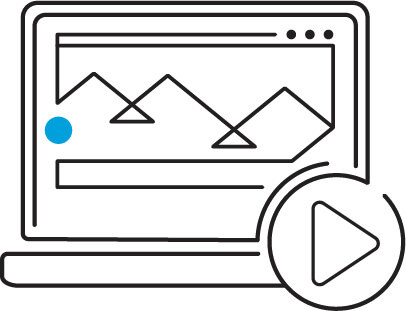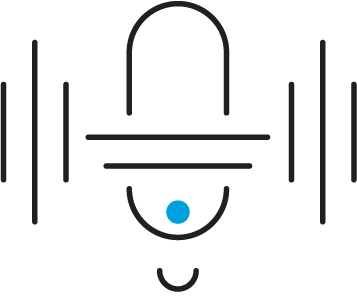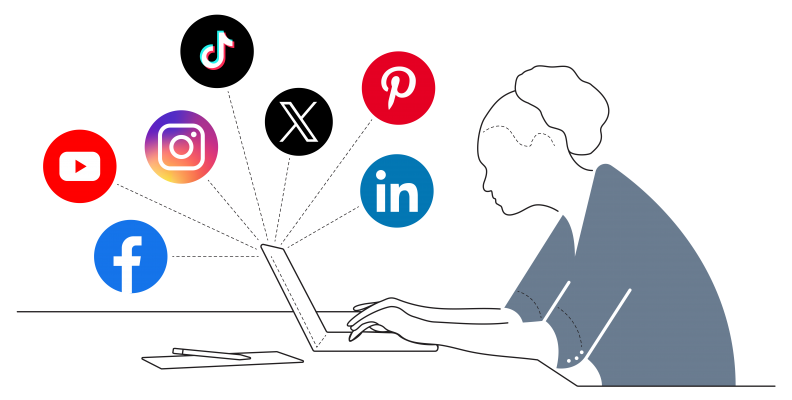Struggling to develop compelling content that truly resonates with your audience can be frustrating, especially when your small or medium-sized business (SMB) is already stretched thin.
Whether you’re trying to attract new leads, convert more customers, or strengthen existing relationships, consistently publishing high-quality material can feel overwhelming under tight financial constraints.
Yet, the rewards of creating engaging content are significant. Businesses that invest in thoughtful and engaging content often experience:
- Stronger brand recognition
- Higher conversion rates
- Deeper customer loyalty
As a strategy to support customer loyalty through brand recognition, 66% of marketers expect their organizations to increase their investment in thought leadership content, according to the Content Marketing Institute.
In this blog post, you’ll learn how to create impactful content with data insights, a focus on quality over quantity, efficient creation methods, and budget-friendly distribution channels—so you can produce meaningful content that captivates your ideal audience without draining your resources.
Use Data-Driven Insights to Understand Your Audience
Before investing time and effort into any form of content, you need to know exactly who you’re speaking to. Data can illuminate your audience’s preferences, behaviors, and intentions so you can deliver material that strikes a chord.
By examining traffic patterns, social media responses, and email metrics, you develop a picture of who is engaging with your brand and why. If, for example, you realize that posts about industry trends spark more comments and shares than other subjects, that’s your cue to lean into those high-potential topics.
Aside from helping you zero in on the right subjects, data also sheds light on the formats that truly resonate, whether it’s blog content, videos, social media stories, or podcasts. When used thoughtfully, data ensures your limited budget goes toward creating smart content that provides value and sparks engagement instead of guesswork.

Conduct Audience Research on a Budget
Collecting valuable insights about your audience doesn’t have to be expensive. Free tools such as Google Analytics show user demographics, location information, your most popular pages, and the pages with the highest bounce rates—all of which reveal insights you can use to shape your ideal audience profiles and content strategy.
If you want to dig deeper, talking directly to current or past customers through short surveys or scheduling interviews can provide additional clarity. You can download free apps to record these conversations and automatically generate transcriptions for future reference.
Leverage Competitor Research to Uncover Content Opportunities
Observing competitors’ channels also offers useful insights into shared audience interests, engagement patterns, and potential content gaps. By analyzing which competitor content performs best, you can identify proven topics that resonate with your target audience without the trial-and-error approach. You can use tools like BuzzSumo or Social Blade to track engagement metrics across competitors’ platforms, then look for underserved niches where your unique expertise can fill knowledge gaps. This strategic competitive intelligence helps you work smarter, not harder, by building on what’s already working in your industry.
Prioritize High-Value Data Based on Your Business Reality
For small businesses with limited resources, focusing on the right data is critical. Start by identifying metrics that directly align with your primary business goals—whether that’s increasing local awareness, driving online sales, or establishing industry expertise. For example, retail businesses should prioritize purchase behavior and product interest data, while service-based companies might focus on lead quality metrics and content that addresses specific customer pain points.
Rather than tracking everything, select 3-5 key performance indicators that provide actionable insights for your particular stage of growth. This targeted approach ensures you’re making data-driven decisions that maximize return on investment (ROI) rather than drowning in metrics that don’t move the needle for your specific situation.
When used together, these audience-focused tactics can help you create a simplified map of your customers’ key concerns, challenges, goals, and preferences without a hefty investment.
Focus on Content Quality Over Quantity
Pumping out frequent but mediocre material can quickly turn off potential prospects and waste time. A well-crafted post—rich with insights, easy to understand, and relevant to your audience—can earn more credibility than a steady stream of shallow updates. By concentrating on substance, you build trust, foster loyalty, and inspire readers, viewers, or listeners to return for more. An engaging article or video also tends to attract shares and referrals, driving further growth.
Here’s a set of guidelines you can follow to help keep your material on point.
- Write with your audience’s perspective in mind. Anticipate their questions and concerns.
- Avoid jargon. Use real-life scenarios and familiar explanations.
- Structure content with subheadings and short paragraphs to improve readability.
- Offer practical tips and next steps so readers can act on your suggestions.
- Spend time revising and proofreading. Clear, polished text enhances clarity, shows professionalism, and has lasting impact.

Maximize Existing Content Assets
Many businesses overlook the untapped value of what they’ve already produced. If older blog posts once sparked strong engagement, revisiting, updating, and re-releasing them can extend their viability.
For example, an evergreen guide on a topic that remains relevant can continue serving your audience for months or even years when refreshed with up-to-date data, revised examples, and new anecdotes. Or a well-performing whitepaper can be summarized into a shorter guide, broken up into a series of blog posts, or transformed into an infographic.
Repurposing existing material not only saves production costs but also provides additional value to your audience by presenting established hits in fresh, digestible formats.
Cost-Effective Content Creation Strategies
Developing meaningful content doesn’t need to be costly; however, choosing the right approach is key. Multiple formats can be effective, and each might fit your goals differently.
Below are a few popular possibilities of types of content to inspire you.

Blogging
Writing and publishing informative, educational, or entertaining articles on a website to engage audiences, boost SEO, and establish thought leadership.
Example: A local accounting firm could publish monthly tax planning articles highlighting seasonal opportunities, such as “5 Year-End Tax Strategies for Freelancers” in December or “How Recent Tax Law Changes Impact Small Restaurant Owners” after new legislation passes.

Video content
Creating visual storytelling pieces, such as tutorials, product demonstrations, or interviews, to capture audience attention and drive engagement.
Example: A boutique fitness studio might create a series of 3-5 minute workout demonstrations showing proper form for exercises taught in their most popular classes, helping potential clients understand their teaching style while providing value to existing members who want to practice at home.

Infographics
Designing visually appealing graphics that simplify complex data, statistics, or concepts into digestible, shareable content.
Example: A B2B software company could create an infographic visualizing customer implementation timelines, showing the average onboarding process from purchase to full deployment (14 days), common implementation milestones, and ROI metrics at 30/60/90 days—data that prospects frequently request during sales calls.

Social media posts
Crafting short, engaging updates, images, or videos tailored for platforms like Facebook, Instagram, LinkedIn, and X to interact with and grow an audience.
Example: A commercial printing service could share LinkedIn posts featuring side-by-side comparisons of standard vs. premium paper stocks for business cards, with close-up macro photography highlighting texture differences and durability tests—positioning themselves as experts while educating procurement teams on quality indicators.

Email newsletters
Sending curated content, promotions, or updates directly to subscribers’ inboxes to nurture leads, retain customers, and drive traffic.
Example: A small business consultancy could send a monthly digest featuring one client success story, three actionable business tips based on recent client challenges they’ve solved, and an invitation to their upcoming workshop on cash flow management for growing businesses.

Podcast episodes
Producing audio-based content, such as interviews or industry discussions, to connect with audiences who prefer on-the-go listening.
Example: A B2B cybersecurity firm could produce a monthly interview series with IT directors from different industries discussing their biggest security challenges, recent incident response scenarios, and practical prevention strategies that worked for their specific company size and compliance requirements.
Selecting formats that match your audience’s consumption habits and your team’s skill set maximizes impact. For visually driven industries—like food, fashion, or art—video and social platforms may shine. In contrast, customers who want in-depth how-tos may benefit more from blog posts, guides, or eBooks. Once you pinpoint a handful of strategies, document your process with a content calendar to help manage consistent output and maintain strategic direction.
Be sure to monitor the engagement on both the channels and the assets in them to help you understand what resonates most with your customers. Use that information to refine your content marketing strategy.
Use AI Tools for Faster Content Creation
Technology has made it easier than ever to produce content efficiently. Free AI resources such as ChatGPT, Claude, and Google Gemini can quickly generate social media captions, blog outlines, or early drafts of articles.
To make the most of these tools, crafting a clear prompt that describes the desired outcome is essential. For example, you might input details on your target audience and ask for a short article with a friendly tone.
While AI-generated drafts give you a strong starting point, it’s important to add your expertise, personality, and brand voice. Thoughtful editing prevents AI content from sounding too generic—or overlook complexities only you can address—and ensures alignment with your audience’s expectations. Applied wisely, AI frees up time without compromising authenticity and helps deliver an accurate, engaging final product.
Embrace Content Repurposing
If you’re working within a tight budget, making each piece work harder for you is vital. You now know that repurposing means reformatting, reusing, or adapting existing material in new ways or for different channels. This extends its lifecycle and broadens your audience reach. But you can also plan to repurpose content as you create it.
For example, a short video discussion based on a popular blog post can become a podcast episode, or a product demonstration can inform webinar content, or the key points from a webinar can become an infographic. You can record the podcast, transcribe it, then use a free AI tool to help create new content from that transcript. For example, AI could create slides from your transcript, write a blog, develop social media posts, and identify snippets of voice content that could be the score for social media videos.
By strategically adapting content to different channels, you can attract varied audiences without the need for constant new production. This approach is especially helpful for smaller teams that can’t produce entirely new content every day
Harness Social Media to Boost Engagement
Social media platforms offer valuable opportunities for building connections without massive expenditures.

For example, you could join groups on Facebook that align with your business to connect with audiences directly, with the caveat of being aware of and following the group’s rules regarding self-promotion and advertising.
Interacting with group members can help build thought leadership capabilities and support being seen as an expert with your ideal audience.
It could also be a great place to get input on your ideal customer profile (ICP) as well as feedback on current or future business ideas. You could also share blogs or new features and ask the group members for feedback. The key is to speak to your audience’s interests or struggles when you post for relevance, so your posts aren’t perceived as pushy or salesy.
Engaging with your audience this way could include sharing behind-the-scenes glimpses of your culture or operations, live office tours, or a short daily update to foster stronger relationships. How-to guides, interactive discussions, polls, bite-sized tutorials, and real-world applications of your products or services enhance engagement further.
Posting a single piece of content across multiple platforms, with slight tweaks tailored for each site, optimizes reach and effectiveness. Short captions with hashtags might thrive on one platform, while a more narrative-style post could resonate better elsewhere. Adapt and experiment, then analyze your results so you can refine your strategy. Over time, consistent, relatable updates generate a loyal following.
Create Compelling Videos on a Budget
Video consistently ranks among the most engaging formats for online viewers. High-end production can be expensive, but there are affordable options.
Here are some best practices and tips to keep costs low while delivering a professional finish to your videos.
- Outline or script your topic first to maintain focus.
- Record with a decent smartphone camera and ensure clear audio by using a cost-effective microphone. There’s nothing worse than videos where you can only hear background noises instead of the speaker!
- Leverage natural light or cost-effective lighting setups for better video quality.
- Keep each clip concise to hold viewer attention.
- Consider adding captions for accessibility and clarity. Tip: note that this capability is often part of video editing apps so be sure to look for that feature before purchasing any apps or programs.
- Experiment with basic editing tools that offer user-friendly features.
When brainstorming ideas, think about showcasing product demos, addressing frequent customer questions, or offering quick tips to keep viewers engaged and foster brand connection. With creativity and attention to storytelling, even low-budget videos can transform casual viewers into invested followers.
Promote Your Content Through Budget-Friendly Channels
Remember that people do business with people. Meaning, they want to know you’re human. So don’t worry about the random “um” or a little background noise in your content; your authenticity is more important than a perfectly produced piece of video or audio content.
However, creating a brilliant piece of content is just the first step; ensuring it reaches a wider audience is equally important.
Here are some straightforward ways to spread your content without spending too much:
- Use free platforms and listings such as Google My Business to stay visible with your audience.
- Reach out to niche websites or blogs for guest-post opportunities.
- Join online communities—like Reddit, Quora, or industry-specific forums—to foster valuable discussions, contribute thoughtful insights, and increase exposure.
- Collaborate with influencers or micro-influencers who align with your brand to introduce your content to broader networks.
- Encourage happy customers and employees to share your work and social posts on their own networks to amplify reach.
While promoting, keep in mind the audiences of each channel. Tailor your message for their interests, and offer genuinely helpful insights, not just promotional copy. Enthusiastic endorsements from a well-aligned influencer or an active online community can lead to a surge of visibility, which is invaluable on a limited budget.
Match Your Content to Each Platform’s Unique Audience
Make the most of your content investment by strategically adapting your materials to fit each social platform’s distinctive environment without creating entirely new content from scratch.
LinkedIn’s professional audience responds best to industry insights, case studies, and thought leadership content with a more formal tone—ideal for repurposing your data-rich blog posts and business analyses.
Facebook users engage more with emotionally resonant stories and community-building content, making it perfect for sharing customer testimonials and behind-the-scenes glimpses that humanize your brand.
Instagram’s highly visual platform demands eye-catching imagery and concise messaging. Consider transforming key statistics from your infographics into standalone carousel posts or turning blog concepts into short-form Reels.
Meanwhile, to create engaging content for X (formerly Twitter), remember the platform users thrive on timely, conversational content that invites discussion. So break down your longer content into thought-provoking questions or bite-sized insights that encourage sharing and debate.
By understanding these platform-specific characteristics, you can efficiently distribute your core content across multiple channels with strategic modifications rather than creating entirely separate pieces for each network. This approach stretches your content budget while maintaining consistent messaging that resonates with each platform’s unique audience expectations.
Master SEO Fundamentals to Attract Quality Traffic
Your own website can be a great place to start with budget-friendly techniques to attract attention. Even with limited resources, implementing basic search engine optimization can dramatically increase your content’s visibility to potential customers actively searching for solutions you provide.
Start by identifying 3-5 primary keywords relevant to your business using free tools like Google Keyword Planner or AnswerThePublic to uncover exactly what your audience is searching for. Prioritize longer, conversational phrases (known as long-tail keywords) that have less competition but higher conversion potential.
Structure your content around these keywords naturally, placing them strategically in page titles, headings, meta descriptions, and within the first 100 words of your content—but always prioritize readability over keyword density. Ensure your website loads quickly (under three seconds) on mobile devices and uses descriptive, keyword-rich URLs that both search engines and humans can easily understand. Local businesses should claim and optimize their Google Business Profile with accurate information, relevant categories, and regular updates to capture nearby customers using location-based searches.
Remember that consistent publishing of helpful, quality content addressing your audience’s specific questions creates natural backlink opportunities and establishes your site as an authority in your niche—both critical factors that search engines reward with higher rankings. For most SMBs, these fundamental tactics yield substantial visibility improvements without requiring significant technical expertise or investment.
How to Use Data Axle USA Data for Engaging Content Creation
Connect with your audience on a deeper level by understanding exactly what motivates their purchasing decisions and content engagement. Data Axle USA’s comprehensive consumer and business information—including demographic details, psychographic insights, and behavioral patterns—helps you speak directly to your customers’ unique needs. By analyzing these data sets, you’ll discover precisely what resonates with different segments of your audience.

For example, you might learn that middle-aged buyers want serious, fact-driven information, while younger consumers are more receptive to lighthearted messaging and social proof. Armed with that knowledge, you can craft distinctly targeted emails, blog posts, or videos, each tapping into unique motivations and pain points.
If you discover that certain groups prioritize budget-friendly deals, you can highlight those benefits prominently. When your content reflects your audience’s needs and what they are looking to solve, it resonates on a deeper level and can support stronger, more enduring connections.
“Understanding your audience isn’t about guesswork—it’s about leveraging data to create content that resonates. The most successful brands use insights to refine their messaging, ensuring every piece of content serves a purpose. Even with limited resources, businesses that tap into audience behaviors and engagement patterns can maximize impact without overspending.”
—Beth Powell, Senior Director of Marketing at Data Axle USA
The ideal outcome of having the right data to work with for your marketing and sales initiatives is moving beyond a successful connection to a business transaction to a loyal, mutually beneficial brand/customer relationship.
Achieve Maximum Content Impact with Minimal Investment
Even with minimal funds, SMBs can develop standout content by tapping into audience insights, focusing on valuable storytelling, testing efficient creation methods, and strategically sharing content across multiple platforms to broaden reach.
Next Steps for Implementing Budget-Friendly Content Strategies
Begin by examining your current content production process to spot any inefficiencies or gaps. Set specific goals for factors such as click-through rates, shares, or conversions, then create a content calendar outlining your main topics and distribution channels. Whenever you publish a strong piece, repurpose it across different formats to maximize returns on your investment.
As results roll in, monitor what gains traction, and refine your approach. Over time, this feedback loop will help you continually produce on-point material that resonates with your target audience—proving you don’t need a massive budget to create meaningful, effective content.
Ready to Use Data to Inform Your Content Strategy?
Content informs your audiences. Data informs your content. Work with our data experts to get the right content to your ideal audiences. We’re always here to help!






